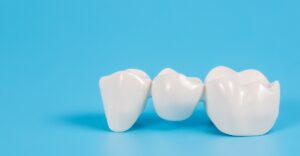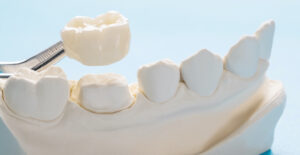
Cavities, a common dental issue, are small pits that form on the surfaces of your teeth as a result of tooth decay. Our teeth start decaying when the acids produced by the plaque and bacteria present in our mouths erode our tooth enamel. Once this protective layer chips away, it leads to weak spots that worsen without treatment and eventually lead to a cavity.
A cavity should be treated right away, and at Warrier Family Dentistry, we treat cavities with composite fillings.
What is a composite filling?
A composite filling uses a composite resin material to fill up the eaten-away part of the tooth and restore your oral health. Composite resins are materials made up of a mixture of different substances, including fine glass and plastics.
Compared to traditional amalgam fillings, composite fillings are a better alternative.
How does Composite filling work?
The material of composite filling is tooth-colored that blends in with the color of your natural teeth. This makes it perfect for treating cavities affecting teeth near the front of your mouth. Instead of simply filling in the cavity, composite resin bonds with your natural tooth structure – which means that less of your natural tooth structure needs to be drilled out to place and set the filling.
How long do composite fillings last?
Compared to amalgam fillings, composite fillings may look like they are not strong enough. But in reality, they are quite resilient and could last for several years. Most composite fillings could last at least 7-10 years without any issues. In many instances, they could last up to 10 years or more.
Factors affecting the longevity of a composite filling
Several factors affect the life and longevity of a composite filling:
1. Location
Composite fillings may wear out faster if placed in your molars. The composite fillings may not last as long if the filling is done on the teeth handling more biting and chewing pressure- like on teeth at the back of your mouth.
2. Size of the Filling
Smaller fillings tend to last longer. If the composite filling covers the larger area of the tooth, chipping or displacement of filling could be a possibility. The larger the area, the more are the chances of developing issues early on in composite filling.
3. Your Eating and Drinking Habits
Foods that you eat affect not just your teeth but composite fillings too!
Sugary or acidic foods and beverages could increase the risk of enamel erosion. This, in turn, weakens the holding of composite fillings around the affected area, and the filling may not last long enough.
4. Bruxism
Do you grind or clench your teeth often?
Bruxism is a condition in which the person grinds or clenches their teeth, putting excessive pressure on the teeth. This pushes amalgam filling, and it may wear out faster.
5. Your Oral Hygiene Routine
If you maintain it, you can make it last longer!
Just like your natural teeth, maintaining good oral hygiene practices is essential for your oral health and your fillings’ longevity. Neglecting routine oral hygiene could lead to new decay around your filling and compromising it. Poor oral hygiene also increases your chances of developing cavities in your other teeth.
6. Dental Techniques Used to Place Your Composite Fillings
An expert hand means your composite fillings could last longer!
How your composite fillings job is done determines how long they will last. First, the affected tooth must be adequately cleaned and dried. Also, the infected area needs to be cleaned, cauterized, and clear of any residual cavity. If the area is not dried correctly, moisture and bacteria can contaminate the treatment area, rendering the composite filling useless and ineffective.
7. Any New Trauma to the Teeth
If you suffer from any new trauma that could affect your tooth structure, it impacts the life of the composite filling.
8. Material Used
Composite fillings can’t last a lifetime, especially since they are placed in a highly mobile area of our body- our oral cavity. Therefore, the type of filling you have also helps in determining how it would last.
Here’s a snapshot of various types of materials used and their longevity as composite fillings for your teeth.
| Type of Filling | Average Duration |
|---|---|
| Amalgam | 15 Years |
| Composite | 7 Years |
| Ceramic | 15 Years |
| Glass ionomer | 5 Years |
What are the options available for composite fillings?
Whether it’s a new or a replacement filling, if you are aware of your options of materials or alternatives to fillings, you will be in a better position to make an informed decision. For example, you can choose from a range of amalgam fillings or opt for composite fillings depending on factors such as cost, aesthetic value, longevity, location, and personal preference. Your dentist can help you choose the best option based on your unique needs and preferences.
Amalgam Fillings Vs. Composite Fillings - Which one is better?
Amalgam Fillings
Also known as silver /metallic fillings, amalgam fillings are a mixture of silver, copper, and tin alloy particles and elemental mercury. Dentists are using amalgam fillings for over 150 years. These are the least expensive type of fillings, and many old-timers may vouch for their durability. A 2008 study claimed that the survival rate of amalgam fillings as provided by private dental practices was between 7.1 and 44.7 years.
The average age of an amalgam filling and its expected replacement duration was about 15 years according to a 2016 study, give or take 6 years on average.
However, according to FDA, a mercury amalgam filling should be avoided altogether in some instances:
- If you are pregnant or planning to become pregnant, or are breastfeeding
- For patients under 6 years of age
- For patients with a pre-existing neurological condition or kidney problems
- Patients having an allergy to mercury
Composite Fillings
The popularity of composite fillings in recent decades is primarily due to their ability to take on the color of the surrounding teeth. They are made from acrylic and ceramic resins, making them a preferred choice for dentists.
Composite fillings can chemically bond with the surrounding tooth with a special adhesive. According to a 2010 study, an average lifetime of a composite filling is about 7 years. However, certain research-based evidence has shown that they can last up to 10 years and beyond, provided the fillings are smaller, and patients have an excellent oral health and hygiene routine.
Another reason why composite fillings are popular is that the same material can be used to repair chipped teeth and fill in the small gaps between teeth.
The average age of an amalgam filling and its expected replacement duration was about 15 years according to a 2016 study, give or take 6 years on average.
However, according to FDA, a mercury amalgam filling should be avoided altogether in some instances:
Other More Expensive Dental Filling Options
Gold Fillings
Gold fillings, a more expensive option than amalgam or composite restorations, are also the most durable. According to research by the American Dental Association, the gold fillings could last an average of 20 years or more.
Ceramic and Glass Ionomer Fillings
Ceramic and glass ionomer beat even the gold fillings in terms of cost. Made with a specific type of porcelain, ceramic, and glass ionomer filling may last 15 years or longer.
They are also the least common types of fillings available. The ceramic fillings are made in a dental laboratory or milling machine. Then, they are glued into the tooth. On the other hand, glass ionomer fillings are made with a type of glass blended with acrylic and can be placed directly in the tooth. They are weaker compared to other fillings and can be used for smaller cavities near the gum line. However, they are not suitable for chewing surfaces. Their lifespan is about 5 years.
Composite fillings are not a cure for decaying teeth. By cleaning and covering the affected tooth, your dentist tries to restrict the further damage that could occur due to tooth decay. They also provide you a much more aesthetic alternative to amalgam fillings. Regular dental checkups can help in determining when a filling may need to be replaced. Dental checkups also help check if any new cavities need to be treated before reaching the filling stage.

Dr. Smita Warrier graduated dental school in 2004 from Tufts University in Boston. She relocated to Charlotte shortly after and started her practice in Ballantyne in 2007. She is very passionate about dentistry and providing top-notch care to her patients. She is a member of the American Dental Association as well as local and state dental organizations. She feels very strongly about staying abreast of the latest technologies and treatment care modalities and dedicates many hours in continuing education. She has been an Invisalign certified provider since 2006.
In her spare time, she likes to run, bike, hike and read. She has done countless half-marathons and several half Ironmans. You can usually find her on the weekends running at the greenway or hiking up in the mountains of beautiful North Carolina with her husband and two boys.












